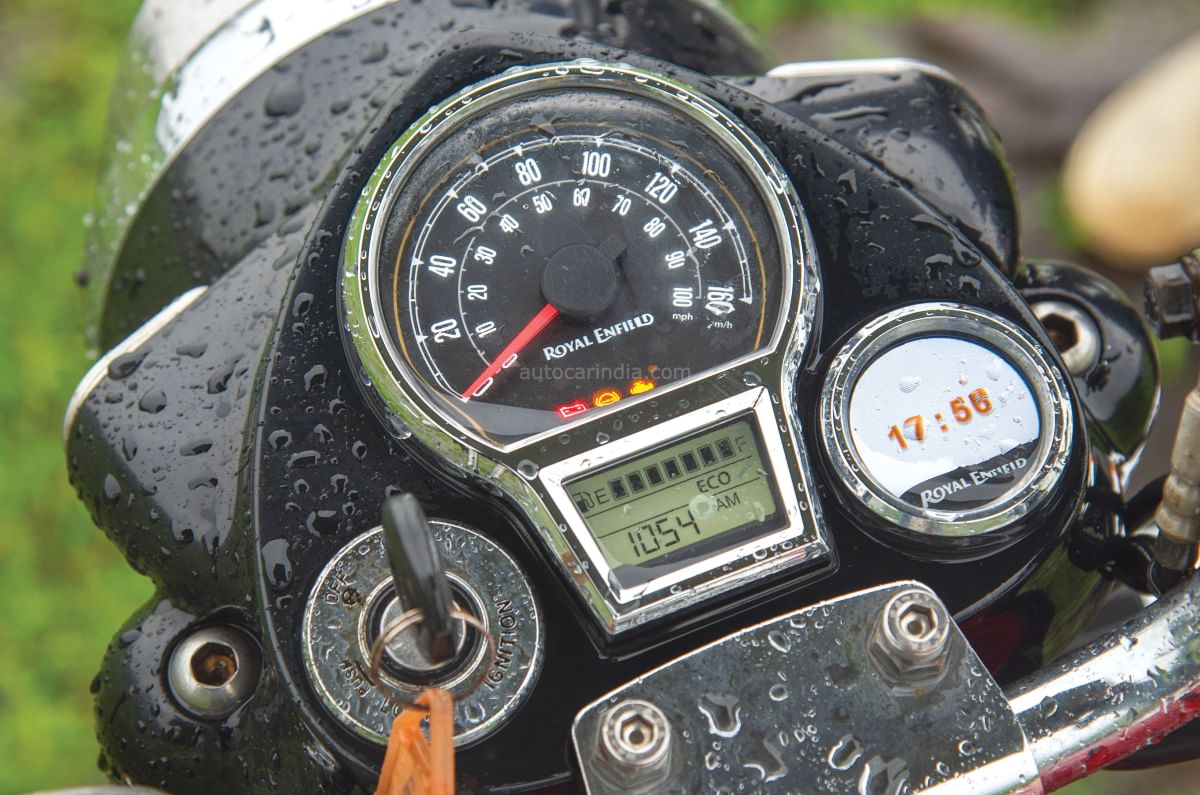Harley X440 vs Triumph Speed 400 vs RE Classic 350 comparison: Battle Royale
Two big-name global brands teaming up with seasoned domestic specialists pose the greatest threat yet to Royal Enfield’s dominance. We investigate just how serious the threat is.
Published on Sep 19, 2023 07:00:00 AM
79,657 Views
The Harley-Davidson X440 and Triumph Speed 400 certainly aren’t the first challengers to Royal Enfield’s domination of the middleweight segment. But it wouldn’t be wrong to say that they are the strongest. The prestige of long-standing, big-name global bikemakers, combined with the manufacturing might and local know-how of domestic specialists is not a blend to be discounted. But the very fact that the competition has had to resort to such amalgamations speaks volumes of RE’s stranglehold over this market. And representing the company’s interests in this comparison is what we believe to be its finest single-cylinder motorcycle – the Classic 350.
HD X440 vs Triumph Speed 400 vs RE Classic 350: engine
Even in a segment that has been known to shun the spec sheet, it’s hard to ignore the Enfield’s handicap. The smallest engine here, producing the least power and torque, powering the heaviest motorcycle. Objectively, it cannot win. But this motorcycle is all about the subject aboard it, and to them, the spec sheet will fade into oblivion. The easygoing nature and feel-good factor of the motor have been painstakingly transferred through decades and across generations, right up to this day. The way it dutifully serves up its dollops of torque at the bottom of the rev range and chugs forward with the thumping soundtrack never gets old. There isn’t much to be gained from revving this motor out, and it certainly won’t win you many races, but if you don’t feel your life has to be lived in the fast lane, this is an extremely pleasant and charming engine to have at your disposal.

For life in the fast lane, there’s the Triumph Speed 400. If the Classic puts a smile on your face with its character, then the Triumph makes you grin with its sheer capability. Roll on the throttle in-gear and it’s quicker than even a KTM 390; keep that throttle pinned as you climb through the ‘box and you’ll see upwards of 160kph on the neat analogue speedo. 100kph comes up in under 7 seconds, and neither of the other two bikes here can come anywhere close in terms of outright performance, responsiveness and thrills. But don’t think of it as one-dimensional – it’s very tractable and geared on the shorter side, making this motor a breeze even in the city. The trade-off for all the performance is that this definitely feels like the busiest engine here, never quite achieving the sedate feeling of the other two at highway cruising speeds. There’s a buzz that becomes noticeable at 5,000rpm and difficult to live with beyond 6,500rpm. It also can’t match the other two motors here when it comes to character.
Bookmarked by the other two here, the Harley’s engine sits rather in the middle, in terms of both performance and feel. It’s certainly not as quick as the Speed 400, but it’s a reasonably fast motorcycle in its own right, sprinting to 100kph in just under 10 seconds if you ask it to. And it’s not quite as brimming with charm and character as the Classic, but it does have a rather likeable identity. It also manages to have more of an emotional connection than the Triumph. It pulls nice and clean at the bottom, then serves up a meaty mid-range, and doesn’t really run out of breath as you rev it out (thoughit does only climb as high as 6,200rpm). It’s also backed up by a rather pleasant soundtrack (once again nicer than the Triumph’s, but not quite as delicious as the Enfield’s), but there is a fair bit of buzz upwards of 4,500rpm. Nevertheless, it makes light work of early triple-digit cruising speeds, and, of this trio, feels the most at ease sitting between 100-120kph.
All three bikes are fairly evenly matched when it comes to fuel efficiency, each hovering around the 30kpl mark both in the city and on the highway. The differences are small, but unsurprisingly, the largest motor here is the least efficient, and the X440 trails behind slightly.
HD X440 vs Triumph Speed 400 vs RE Classic 350: ride and handling
Each of these motorcycles carries its identity over to the handling department as well. As the most easygoing bike here, the Classic is also the least willing to play along to your shenanigans in the corners. That said, it will put up with them if you so insist, and is greatly better in this regard than its predecessors. At the opposite end sits the lithe and agile Speed 400, which tips into corners very naturally, steers quickly and can very easily keep you engaged and entertained on a twisty mountain road.
On paper, the X440 is less than 5kg lighter than the Classic, but from the saddle, the difference feels more pronounced. It certainly isn’t as light on its feet as the Triumph, but it does a great job of masking its weight, and never becomes as much of a handful as the Enfield. It also feels like the lowest seat height of this bunch, even though on paper that spot belongs to the Speed.
With its performance levels, you might think that the Triumph would be the most hard-edged motorcycle here. But you’d be wrong. Perhaps the biggest highlight of the Speed 400 is its absolutely sublime ride quality. It tends to the softer side, but feels almost perfectly suited to our roads, gobbling up even the nastiest road imperfections with consummate ease. And despite this, body control always remains well in check at all times. It’s only when pushing really hard at a racetrack that the soft setup will begin to become a limiting factor, and this is something only a handful of owners are likely to ever do with their bikes.
The Classic has a more heavy-handed approach to ride quality, almost steamrolling the road underneath you, but never quite reaching the same level of plushness as the Speed. For its heft, it could also do with more powerful brakes. The Harley does a better job in this department, but it’s the Triumph that has the sharpest stopping setup here.
While by no means a poorly riding motorcycle, the X440 does seem to lag behind the other two bikes in this regard. The rear shocks have a slight firmness to them, but, inspite of this, it manages to deliver a reasonably absorptive ride. But the front fork tends to bottom out with a rather harsh impact over nasty potholes.
HD X440 vs Triumph Speed 400 vs RE Classic 350: seating comfort
Where the Triumph remains true to form is in the way it seats you. The riding position aboard the Speed 400 is the sportiest and most engaging of the lot, with the most rearset foot pegs. That said, it certainly isn’t uncomfortable or overly committed by any means, and the spacious seats here are actually the most comfortable of the lot. But it certainly doesn’t feel like a substantial motorcycle underneath you.
For that, you’ll need one of the other two. The Classic never fails to make you feel special from the saddle, with its upright king-of-the-road riding position and delightfully simple retro instruments staring back at you. On the X440, the feeling of substance comes from the wide fuel tank between your legs, and the overall length and stance of the motorcycle. But inconsistent quality and finish levels rob you of a truly special feeling, and this is disappointing considering the badges and the price point.
The Classic 350 marked a significant step up in finish levels and attention to detail for Royal Enfield when it was first introduced, and it continues to feel like a well-built and well-finished motorcycle. But in this regard, even the RE is outclassed by the Triumph. Whether it’s in the materials used, the neatness of everything or the attention paid to the finer details, the Speed 400 feels truly exquisite, and all this is even more exceptional when you factor in the price point.
Features aren’t a weak link for the Triumph either, with ride-by-wire, traction control, an immobiliser, a slip-assist clutch and all-LED lighting on offer. The Harley misses out on traction control, but does throw in a Bluetooth-equipped TFT display on all variants, with a host of connectivity features on this top ‘S’ variant. However, this version is close to Rs 50,000 more expensive than the next bike here, and that’s not something you can discount easily. Royal Enfield has kept the Classic true to its retro roots and what you get here are bare necessities like dual-channel ABS and a fuel gauge. While this approach does have its charm, a gear position indicator would go a long way here.
HD X440 vs Triumph Speed 400 vs RE Classic 350: verdict
If all you want is the most capable motorcycle here it is undoubtedly the Triumph Speed 400. Its competence and range of abilities are unparalleled. Despite this, it’s a far more agreeable motorcycle than something like a KTM 390, and comes across as very comfortable and easy to ride. There are also great features and quality levels on offer, and the price that all this comes at is truly remarkable. But it definitely doesn’t have a feeling of calm about it. If a relaxed and easygoing motorcycle is what you’re after, the Speed is not likely to float your boat, and your choice comes down to the other two.
There is a lot to like about the Royal Enfield Classic 350. But you do get the feeling that the ceiling is a little low on this bike – you will reach its limitations rather quickly. This problem would be solved by a hypothetical new-age Classic 500 offering you a larger playground and a higher ceiling. But alas, RE isn’t known to be working on any such motorcycle at the moment.
However, that is essentially what the Harley-Davidson X440 is offering in many ways. It achieves an impressive blend of the Classic’s charm and some of the Triumph’s capability, striking a very appealing middle ground. Throw in the immense brand value of its badges and the commanding road presence, and this is a bike that could draw quite a few buyers away from Royal Enfield showrooms.
Related Images
Related Videos
Copyright (c) Autocar India. All rights reserved.



